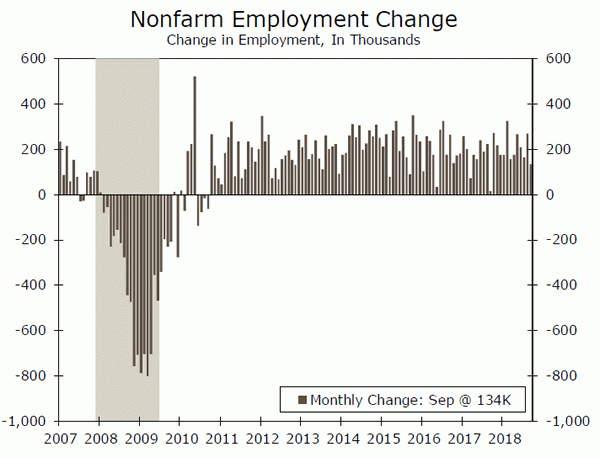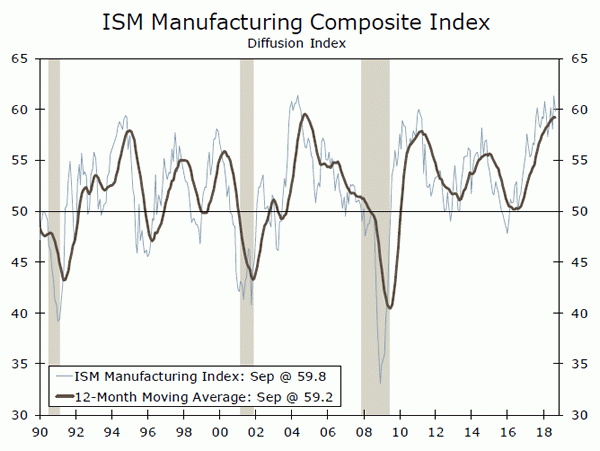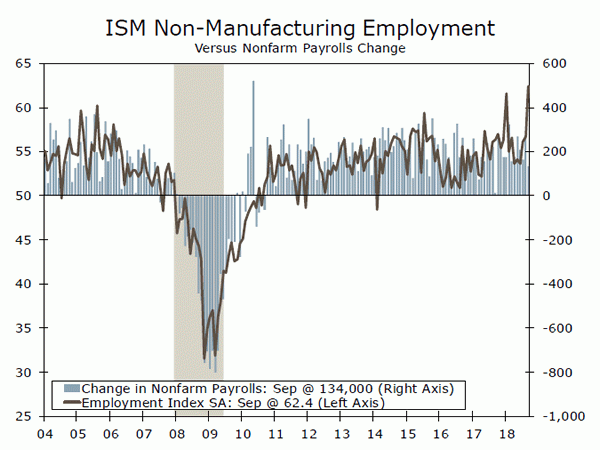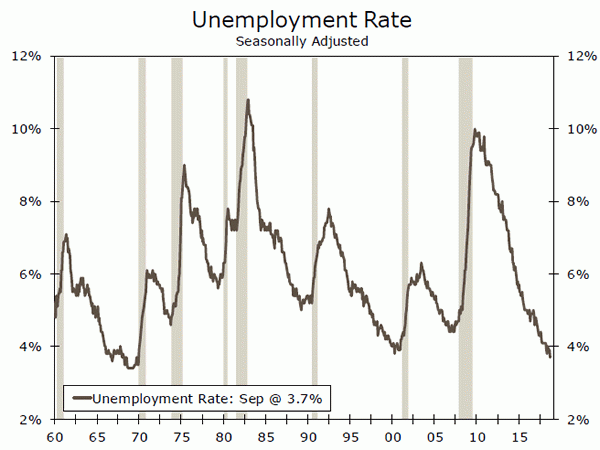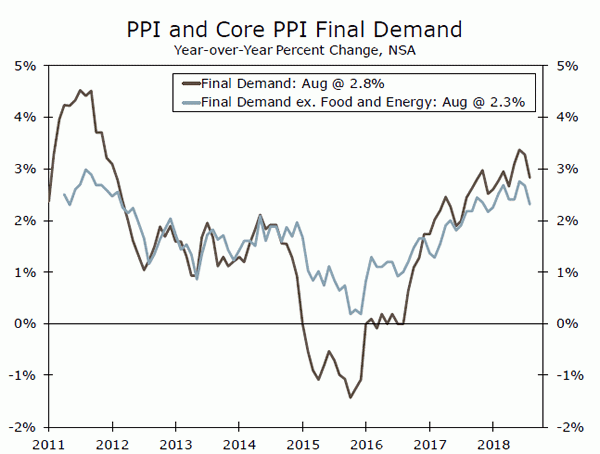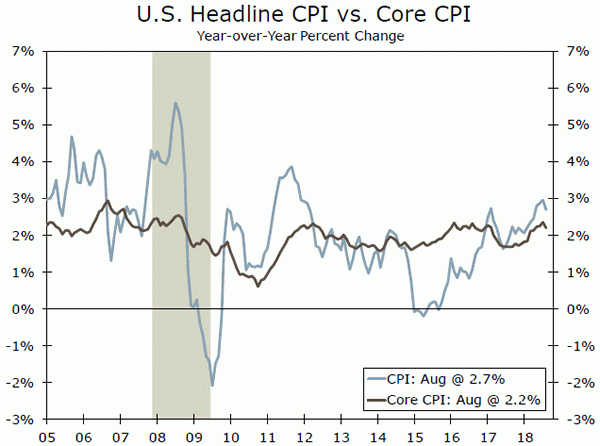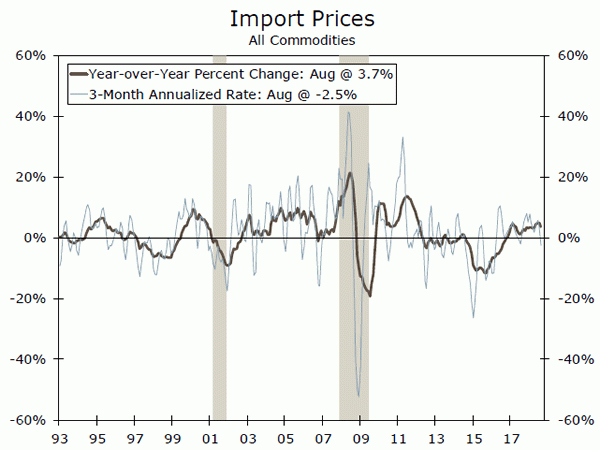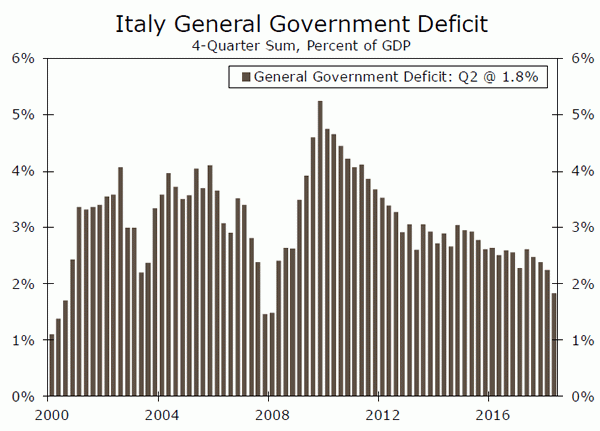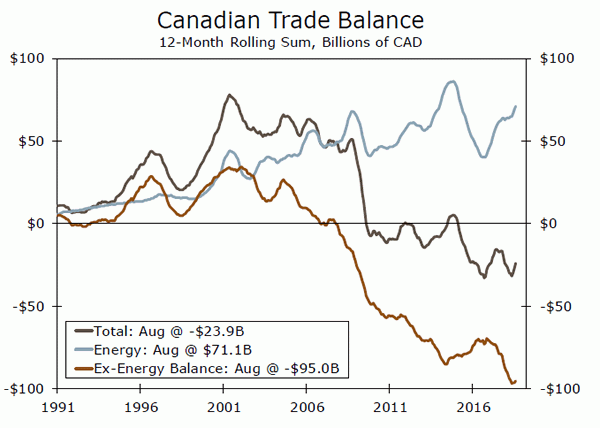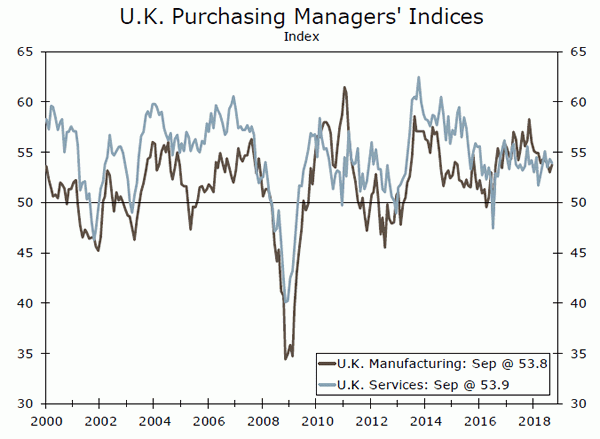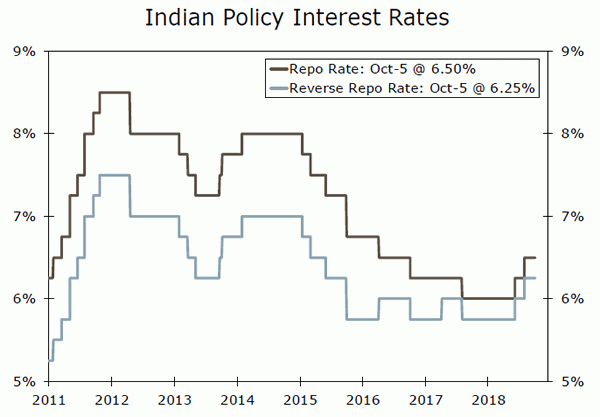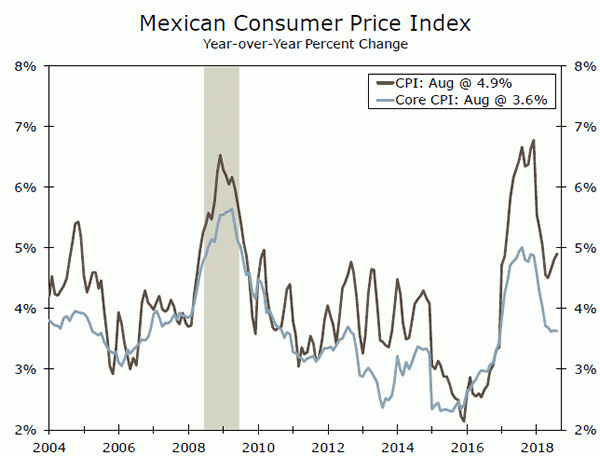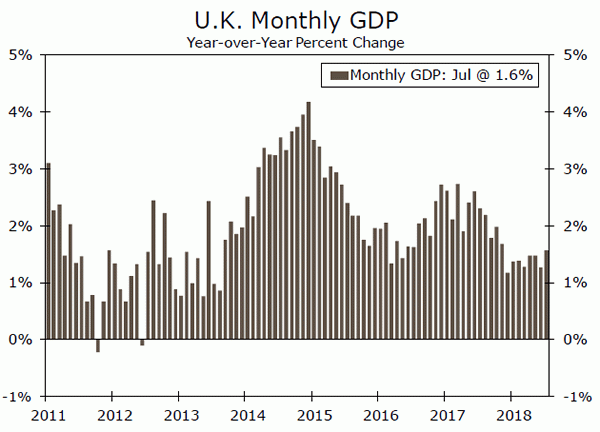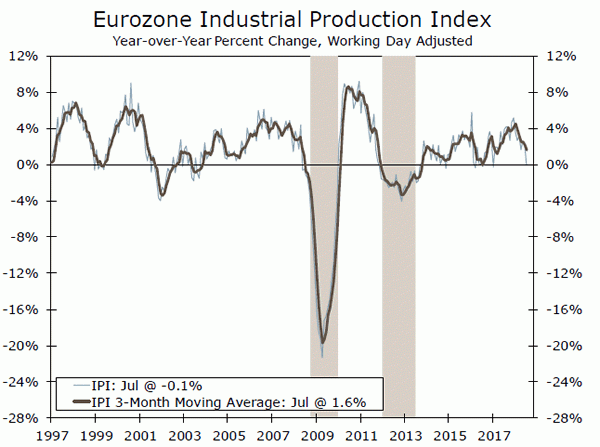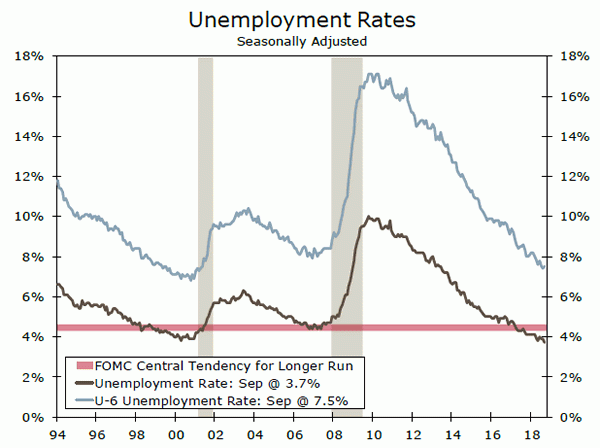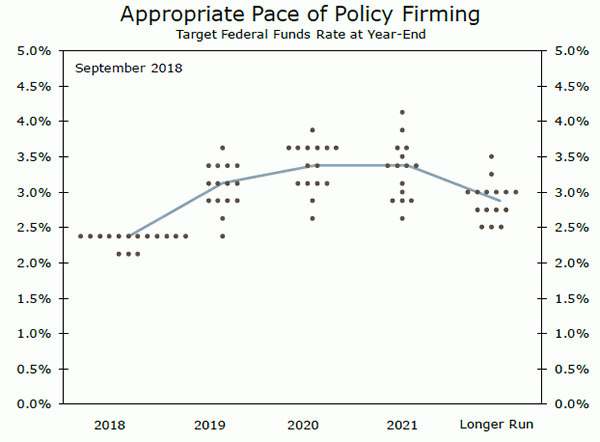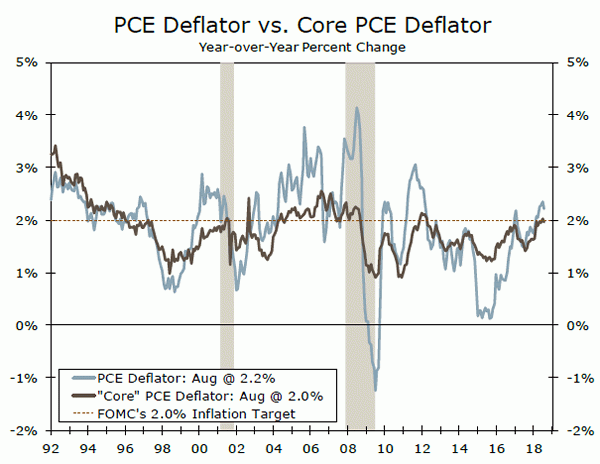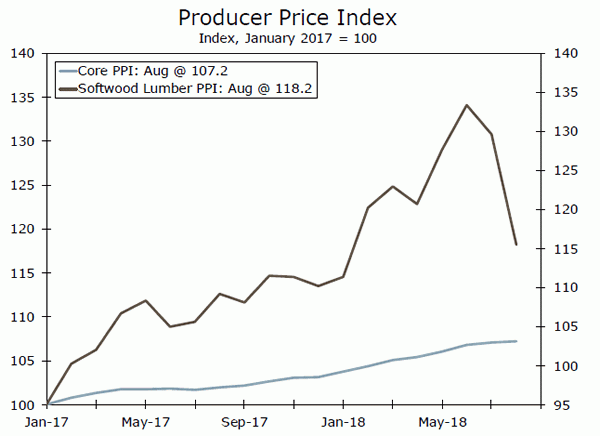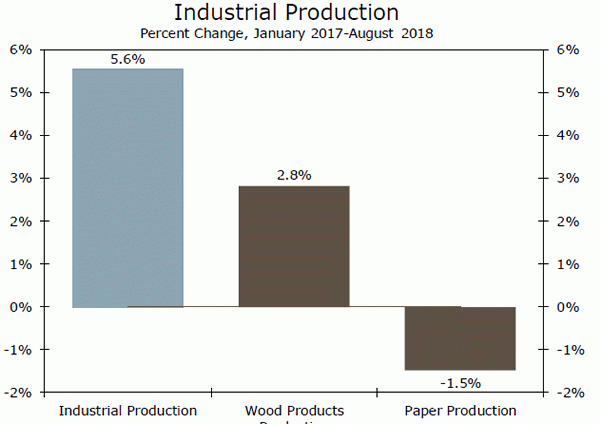Weekly Economic and Financial Commentary
U.S. Review
Hurricane Distortions Hold Back September Job Growth
- The September ISM Manufacturing Index came in slightly below expectations, at 59.8, but remains above its average for the past year.
- Motor vehicle sales substantially topped expectations in September, climbing to a 17.4-million unit pace.
- Factory orders climbed at the fastest pace in August in nearly a year, suggesting business fixed investment rose solidly in Q3.
- Employers added 134,000 jobs in September and the unemployment rate fell 0.2 percentage points to 3.7%. Wages remain on an upward trajectory, rising 2.8% year-over-year.
Not Good, They’re Great!!!
Fed Chairman Jerome Powell has used a variety of superlatives to express his pleasure with the current state of the U.S. economy. Powell believes the economy is in a good place, with exceptionally low unemployment and inflation close to target. With inflation expectations in check, the Fed continues to believe it can gradually nudge interest rates higher. A growing chorus of Fed officials is also beginning to question what full employment actually is, suggesting policy will likely remain on its current track even if the unemployment rate falls below the Fed’s expectations.
With one big exception, the majority of this week’s economic reports came in on the strong side. The ISM manufacturing survey fell 1.5 points to 59.8 in September but has been hanging around the 60 level in recent months and remains slightly above average for the year. Any reading above 50 means that more manufacturers see business conditions improving than see them worsening. At the current level, the ISM index would be consistent with GDP growth in the 5% range—well above our forecast for Q3—and strong industrial production growth. While the ISM headline index remains near its recent high, many of the more leading components moderated this past month, suggesting manufacturing may moderate in coming months. The new orders index fell 3.3 points to 61.8, which is slightly below its average for the past six months. Order backlogs and supplier deliveries also dropped during the month, while the employment index rose.
The ISM non-manufacturing index climbed 3.1 points to 61.6 in September. Business activity rose 4.5 points to 65.2 and the closely watched employment index jumped 5.7 points to 62.4. The surge in the employment series raised expectations for the September jobs report, particularly since it was accompanied by more good news from the ADP employment survey, which reported a gain of 230,000 jobs in September, and weekly unemployment claims, which fell back to the lowest levels since the late 1960s.
While the stage was set for another big gain in nonfarm employment, the actual numbers for September came in short of expectations, with payrolls adding just 134,000 jobs. Employment growth for the prior two months was revised higher by 87,000 jobs, which brought the three-month average up to 190,000 jobs. The shortfall in nonfarm jobs appears to be partly due to estimates of how Hurricane Florence impacted employment. Employment at restaurants tumbled by 18,200 jobs, and 20,000 jobs were lost in retailing. We saw similar but larger impacts last year, with Hurricanes Harvey, Irma and Maria. After revisions, the employment losses from those storms do not look quite as severe as they did initially, which may be why the market largely looked past this morning’s surprisingly small job gain.
The unemployment rate is less impacted by hurricane distortions. The latest drop to 3.7% results from a large 420,000-person rise in household employment and a more modest 150,000-person rise in the civilian labor force. September’s drop in the unemployment rate matches up well with weekly first-time unemployment claims, which are also at the lowest level since the late 1960s.
U.S. Outlook
PPI • Wednesday
Producer prices fell 0.1% in August, but the underlying details revealed that the below consensus print was not as benign as the headline index indicated. Core price inflation, which excludes food, energy and trade services, came in a bit softer than expected, but still edged up 0.1% during the month. The miss stemmed mostly from a 0.9% drop in the volatile trade-services sector. Over 80% of the drop in prices occurred as a result of declining margins for machinery and equipment wholesaling, suggesting producers may be having a difficult time passing on rising input costs related to recent tariffs. The index for final demand goods was unchanged.
While the topline reading for producer prices came in softer than expected, the “core-core” measure is up 2.9% over the past 12 months and has maintained an upward trend. We expect prices to continue to gradually climb and exert further pressure on margins.
Previous: -0.1% Wells Fargo: 0.2% Consensus: 0.2% (Month-over-Month)
CPI • Thursday
Consumer prices rose 0.2% in August, coming in slightly below market expectations. Over the past 12 months, inflation has now moderated to 2.7% alongside easing energy prices. Core inflation increased a modest 0.1%, but followed a strong reading in July. Core goods prices fell for the first time in three months, as apparel prices fell 1.6%, reflecting renewed downward pressure on core goods prices owed to recent dollar appreciation. Core services inflation softened during the month to 0.2%. Physician services and hospital prices edged down. However, costs for housing and transportation continued to rise.
We maintain our view that inflation should continue to steadily trend upward. The current inflation environment remains in-line with Fed expectations as core inflation has gradually moved up to the FOMC’s target. However, there is little indication that inflation will accelerate and force the Fed to raise rates sharply.
Previous: 0.2% Wells Fargo: 0.2% Consensus: 0.2% (Month-over-Month)
Import Prices • Friday
Import prices dropped 0.6% in August, following a 0.1% fall in July. Lower fuel prices and a strengthening dollar this year are likely behind the recent weakness in prices. The monthly decline was the steepest since January 2016 and largely occurred as a result of a 3.9% drop in import fuel prices. Nonfuel prices edged 0.1% lower, driven by lower industrial supplies and materials and capital goods prices. Export prices also registered a 0.1% drop.
While trade disputes with China continue to escalate, tariffs are not included in import prices, as they are applied after. The effect of import prices on consumer prices is also somewhat limited by the fact that most imports are goods and the bulk of consumer spending is services oriented. Softer import prices will likely have negligible effects on overall inflation, which continues to trend higher. We anticipate import prices will rebound modestly from their current slump.
Previous: -0.6% Wells Fargo: 0.3% Consensus: 0.2% (Month-over-Month)
Global Review
Policy in Focus for Financial Markets
- In what was a steady week for international data, policy developments garnered the most attention from market participants. In particular, Canada reached a deal on a trade agreement with the U.S. and Mexico, an agreement we believe improves Canada’s prospects and strengthens the growth outlook for the Canadian economy.
- In Europe, the week began with a standoff between Italy and its European partners over Italy’s budget deficit. By week’s end, a compromise seemed to have been reached, with Italy proposing a deficit of 2.4% of GDP for 2019, narrowing to 1.8% of GDP by 2021.
Trade Cloud Lifts for the Canadian Economy
The most significant event this week occurred last weekend, as Canada reached a deal with the U.S. (and Mexico) on a trilateral trade agreement, called the U.S.-Mexico-Canada Agreement, or USMCA. For Canada, among some of the key elements of that agreement were specifics related to the auto sector, the retention of some important dispute resolution mechanisms and an extended lifespan for this new agreement. By lifting investment uncertainty and maintaining access to key export markets, the agreement in our view strengthens the outlook for the Canadian economy through 2019 and 2020.
This week’s Canadian data were mixed. The August trade balance improved to a C$0.53 billion surplus, though on a broader basis we note Canada has a large energy trade surplus, and a large deficit on non-energy products, highlighting the importance of this week’s trade agreement. September employment rose by 63,300 but hourly earnings growth for permanent employees slowed to 2.2% year-over-year, while the September Ivey PMI fell to 50.4.
Europe: Some Policy Progress, Mixed Economic Data
The most significant European development this week was some easing in the stand-off between Italy and its European partners over Italy’s budget deficit. Italy had initially proposed a deficit of 2.4% of GDP for 2019 through 2021, but subsequently agreed to a compromise which sees the deficit at 2.4% in 2019, and narrowing to 1.8% by 2021. Of course, the challenge of formulating a detailed budget and actually meeting those budget targets still remains.
On the data front, Eurozone August retail sales disappointed, with an unexpected 0.2% month-over-month decline, while July sales were also revised lower. In the U.K., the September services PMI fell to 53.9, although the manufacturing PMI was a bit more encouraging, rising to 53.8. For the time being, however, Eurozone and U.K. data remain consistent with subdued economic growth, with little evidence so far of any significant upswing.
Central Banks: Little Talk and Less Action
It was only a moderately busy week for central banks, with monetary policy announcements spurring only limited excitement. The Reserve Bank of India unexpectedly held its repo rate at 6.50% and held its reverse repo rate at 6.25%, with a recent slowing in CPI inflation outweighing solid economic growth (Q2 GDP growth firmed to 8.2% year-over-year, the fastest pace since early 2016). Still, the central bank described its policy stance as one of “calibrated tightening”, suggesting further rate hikes remain likely in the coming months.
The other central banks were also inactive in this week’s announcements. The Reserve Bank of Australia kept its Cash Rate at 1.50% as expected, and gave no indication in its accompanying statement that it is likely to adjust interest rates any time soon. Poland’s central bank kept its policy interest rate at 1.50% and said that rates would stay unchanged until the end of 2019 and possibly into 2020. Finally, Mexico’s central bank kept its overnight rate at 7.75%, where it has been since June this year.
Global Outlook
Mexico CPI • Tuesday
Mexico’s September consumer price index is released next week, and may reveal some easing in inflation pressures. Inflation surged in 2017 as the currency slumped and the economy maintained reasonable momentum (or at least did not fall into recession). Inflation has slowed through most of 2018, however, as the Mexican peso has stabilized. The headline CPI rose 4.9% year-over-year in August, and for September inflation is expected to be little changed at 5.0%. For now, inflation is too high and the currency is too volatile for Mexico’s central bank to consider easing, and the central bank kept its policy rate at 7.75% this week.
August industrial production growth is also due, and is forecast to firm to 1.3% year-over-year. The industrial sector could potentially firm further in coming months after the recently announced trade agreement with the U.S. and Canada, which should help lift investment uncertainty and maintain access to key export markets.
Previous: 4.9% Consensus: 5.0% (Year-over-Year)
U.K. GDP • Wednesday
Earlier this year, the U.K. statistical office began publishing monthly GDP estimates, a more timely complement to its comprehensive quarterly GDP data. In recent months U.K. GDP has been relatively solid, rising 0.3% month-over-month in July, led mainly by the 0.3% rise in the services sector. Construction activity rose 0.5% month-over-month, while industrial production rose by a lesser 0.1%. After a few months of relatively solid gains, a smaller increase in August would not be a surprise, and the consensus looks for a gain of 0.2% month-over-month.
In addition to August GDP, industrial and manufacturing figures are also due next week. Overall, activity in the industrial sector has been somewhat subdued. August industrial production is expected to rise 0.1% month-over-month and manufacturing production should also rise 0.1%. Finally, the August trade balance is released, with a deficit of £10.90 billion expected for the month.
Previous: 0.3% Consensus: 0.1% (Month-over-Month)
Eurozone Industrial Production • Friday
It is a busy week on the industrial front in Europe next week, with several reports on industrial activity for August due for release. Manufacturing has been something of a soft spot for the Eurozone, with survey data subdued and July industrial production falling 0.8% month-over-month. Within the details, production of consumer goods dropped noticeably along with production of intermediate goods. There were, however, monthly increases in the production of capital goods (0.8%) and energy (0.7%).
For August, the consensus expects some recovery of the July decline, with industrial production seen rising by 0.3% monthover- month. On a geographical basis that gain is expected to be relative broad-based, with German production seen rising 0.3%, French production rising 0.4% and Italian production rising 0.8%. With manufacturing soft and services activity steady rather than strong, Eurozone GDP growth likely remained modest in Q3.
Previous: -0.8% Consensus: 0.3% (Month-over-Month)
Point of View
Interest Rate Watch
Too Good To Be True?
The economic projections released by the FOMC last week showed that the committee expects unemployment to fall to a 50-year low of 3.5% by the end of 2019, while core inflation stabilizes only a touch above target at 2.1%. Tight labor markets and low inflation have been exceptionally rare in the United States during the post-WWII era, which has evoked skepticism about whether the Fed can achieve such a Goldilocks scenario.
In a speech this week, Chairman Powell discussed that such an extraordinary outcome may be achieved in the current environment thanks to the weakening relationship between labor market slack and inflation. In his view, the flattening of the Phillips Curve has come about in no small part to better monetary policy. Specifically, the anchoring of inflation expectations since the “Great Inflation” of the 1970s has better insulated inflation from variations in labor market tightness.
Inflation expectations, especially those for the near-term, have drifted up over the past year. Long-term expectations, however, remain noticeably below the rates reached prior to the 2014-2016 commodity rout.
While inflation expectations may be giving the FOMC the green light to continue tightening at a historically slow pace, price pressures are nonetheless building. We expect core PCE to rise faster than the FOMC. Tariffs have piled up to a point where they are now likely to impact inflation, even in a services-dominated economy like the United States. Moreover, they may be the push companies need to raise prices in light of strained capacity. The share of businesses raising prices is near the highest levels since 2008.
Given that inflation has fallen short of the Fed’s target for most of the expansion, an overshoot moderately above the Fed’s current 2.1% estimate is unlikely to persuade the Fed to ratchet up the pace of tightening unless long-term inflation expectations become unglued. However, it could lead the FOMC to ultimately raise rates more than what it has currently outlined, which is already above what markets expect for 2019 and 2020.
Credit Market Insights
Homeownership and the Recovery
Aggregate household wealth in the United States surpassed its pre-recession peak in 2012 and has continued to rise as the economic expansion closes in on the longest on record. However, the fact that around 80% of that wealth is held by the top decile of households merits a closer look at the distribution of wealth accumulation during the recovery. The more granular data of the Fed’s Survey of Consumer Finances reveal that real wealth has yet to surpass 2007 levels for the bottom 90% of households.
One major driver of the disparate wealth trajectories is the growing skewness of stock ownership toward upper income households. Moreover, the bottom 90% has seen a marked decrease in the homeownership rate and has thus missed out on the recovery of home values to record levels. We have repeatedly discussed the ongoing challenges in the housing market, including inability to afford a down payment and worsening credit availability. Indeed, the conventional 30-year mortgage rate rose to 4.71% this week, a seven-year high. As the sustainability of the expansion comes under closer inspection, it is worth reflecting on the linkages between wealth and consumer spending, the largest component of the economy. Future trends in homeownership and the broader distribution of wealth accumulation could very well have implications for the future trajectory and ultimate end date of this expansion—one that has been called a “wealthless recovery” and led Chair Powell to consider whether our current situation is “too good to be true”.
Topic of the Week
Tariffs’ Lessons So Far: Proceed with Caution
As international trade tensions were beginning to escalate in April, we wrote a report considering how costly a full-blown trade war would be. At the time, the United States had announced plans to impose tariffs on $50 billion worth of Chinese imports and China had retaliated in kind. We noted in that report that the business environment would be more challenging for some American industries, but a full-blown trade war “would not necessarily bring the U.S. economy to its knees, due to the relatively small amount (in terms of overall value added) that the United States exports to China.” Indeed, China has more to lose.
Nearly six months on, we believe that it is time to re-examine our analysis in light of recent developments. Namely, on September 24, the United States imposed tariffs on another $200 billion worth of Chinese imports, and China retaliated by targeting an additional $60 billion worth of American exports. In the first of a two-part series, we analyze the effects that American tariffs on softwood lumber, washing machines and steel have had on prices, output and employment in those industries. Are there any lessons for the industries that will be affected by the most recent tariffs from the import taxes that have already been enacted?
Tariffs have raised prices in the affected industries. However, outside of that intuitive point, the conclusions are not perfectly clear cut as we find modestly negative effects on output and employment in some, but not all, of the industries we analyze. Admittedly, it may be too soon for the effects of the levies to be fully reflected in industry output and employment, and we acknowledge that those factors could be affected by factors other than tariffs.
When we wrote our initial report six months ago, we concluded that the “first order” effects of a trade war would not be large enough to push the U.S. economy into recession. We stand by that conclusion. However, it also seems that the first order effects on the industries that received tariff protection are modestly negative, at least so far. In a follow-up report, we will turn our attention to the “second order” effects of American tariffs and the effect of Chinese levies on U.S. exports. Stay tuned.




